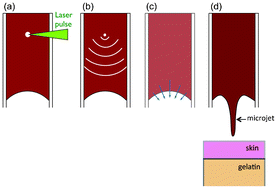Needle-free injection into skin and soft matter with highly focused microjets
Abstract
The development of needle-free

* Corresponding authors
a
Physics of Fluids Group, MESA+ Institute and Faculty of Science and Technology, Burgers Centre for Fluid Dynamics, University of Twente, P.O. Box 217, 7500 AE Enschede, Netherlands
E-mail:
y.tagawa@utwente.nl, c.sun@utwente.nl, d.lohse@utwente.nl
Fax: + 31 53 489 8068
Tel: + 31 53 489 2470
b Department of Dermatology, Leiden University Medical Center, Leiden, The Netherlands
The development of needle-free

 Please wait while we load your content...
Something went wrong. Try again?
Please wait while we load your content...
Something went wrong. Try again?
Y. Tagawa, N. Oudalov, A. E. Ghalbzouri, C. Sun and D. Lohse, Lab Chip, 2013, 13, 1357 DOI: 10.1039/C2LC41204G
To request permission to reproduce material from this article, please go to the Copyright Clearance Center request page.
If you are an author contributing to an RSC publication, you do not need to request permission provided correct acknowledgement is given.
If you are the author of this article, you do not need to request permission to reproduce figures and diagrams provided correct acknowledgement is given. If you want to reproduce the whole article in a third-party publication (excluding your thesis/dissertation for which permission is not required) please go to the Copyright Clearance Center request page.
Read more about how to correctly acknowledge RSC content.
 Fetching data from CrossRef.
Fetching data from CrossRef.
This may take some time to load.
Loading related content
